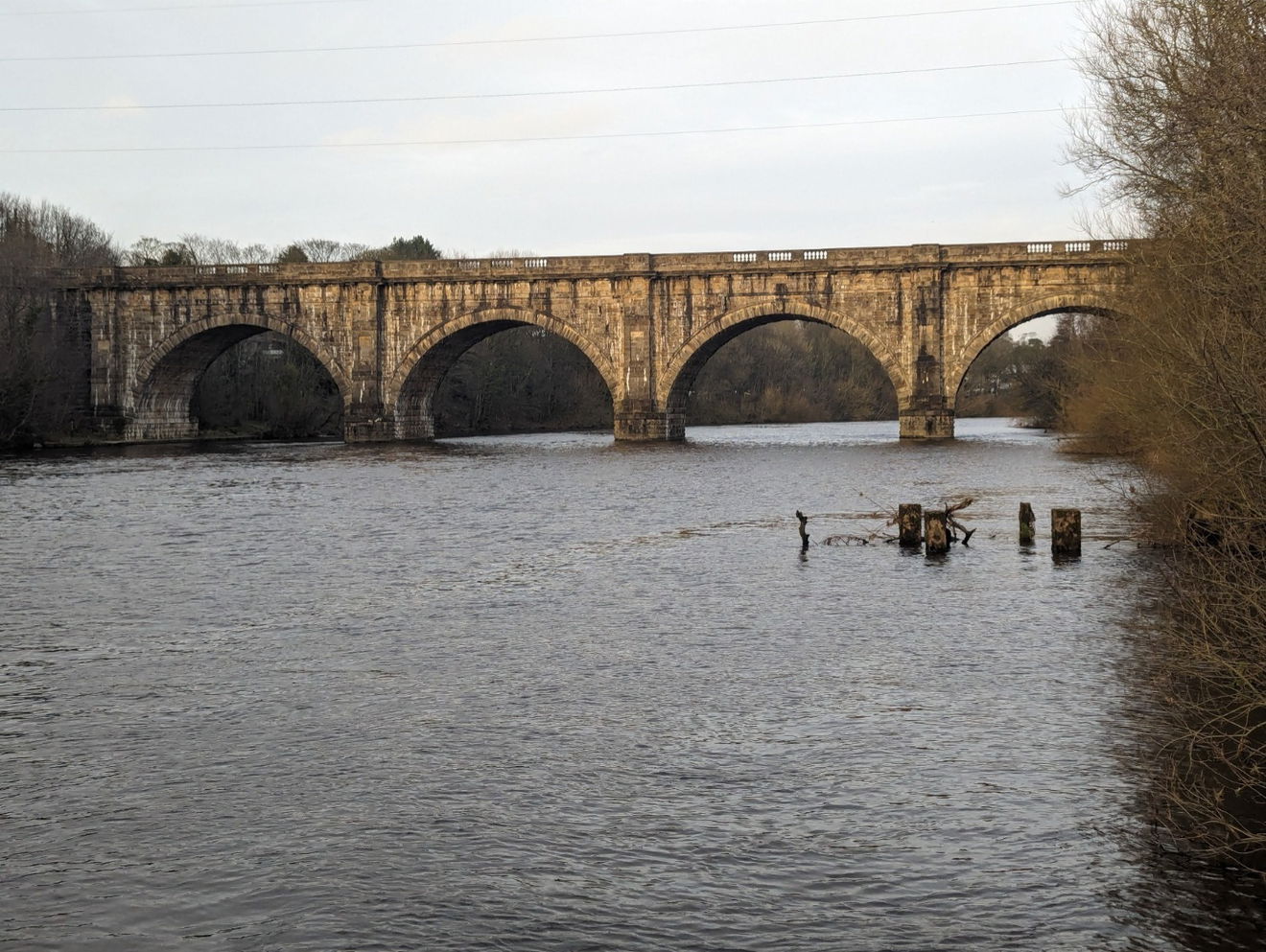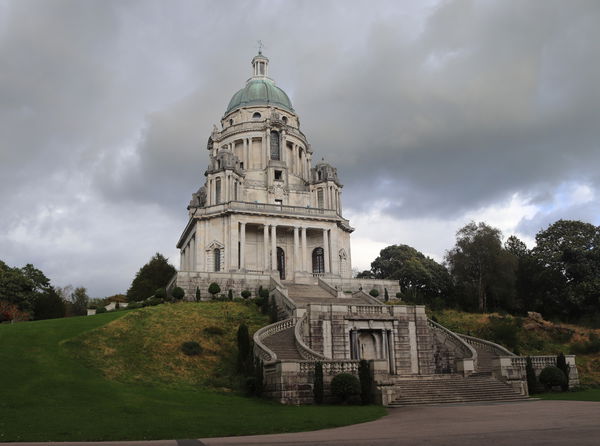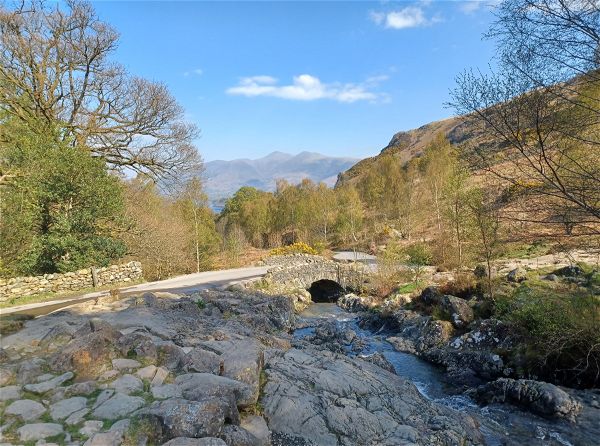Lune Aqueduct
Bridge In Lancaster, Lancashire
A Georgian Grade I Listed aqueduct, the largest all-masonry aqueduct in Britain taking the Lancaster Canal over the River Lune.

The Grade I Listed Lune Aqueduct is the largest all-masonry aqueduct in Britain and is an impressive example of Georgian Engineering as it crosses the River Lune in Lancaster. It was completed in 1797 and runs at 202 metres long, spanning five arches which carrying the Lancaster Canal 16 metres above the River Lune below.
Construction on the aqueduct commenced in January 1794 and to ensure it was completed as quickly as possible around 150 men worked on it day and night until its completion in 1797.


The aqueduct was designed by canal engineer John Rennie and constructed by Alexander Stevens. Its purpose was to remove the need for any locks on the canal. Indeed, Lancaster Canal has 41 miles of lock free waterways, the longest stretch in England. For those looking for flat walking then the canal offers this!
John Rennie the Elder (to distinguish himself from his son of the same name) was well known for his work on Britain's waterways whilst Alexander Stevens sadly passed away during construction and his role was taken over by his son, also called Alexander Stevens!
The Lune Aqueduct is a huge and impressive structure, it's five arches are enormous in size with a series of balusters over each arch. It was said that these would help blend the aqueduct into the surrounding area! It's incredible to think that it carries the whole Canal over the River.
The channel for the canal itself is 2.3 metres below the towpath and contains a plug which can be pulled to allow the aqueduct to be drained into the river allowing repairs to be undertaken. The Canal Trust itself has pictures from June 2020 showing the aqueduct drained whilst repair works were undertaken and it is quite the sight!


The aqueduct was clearly well received with artist J.M.W Turner visiting the site on multiple occasions, producing a number of pieces of work both of the aqueduct itself and of the views from it. This was apparently unusual for Turner as the aqueduct marked a shift on his Northern Tour of 1797 where, having otherwise focused on older and historical landscapes, his attention turned to something modern. Turner must have been impressed. Both the views of the aqueduct and from it still impress today.
Perhaps like some more recent projects (which I'm sure readers will be familiar with!), the construction of the aqueduct ran significantly over budget. John Rennie's first estimate was £16,647 (over £1m today). In the end the foundations alone cost this with the rest of the aqueduct clocking in at over double this. The whole aqueduct cost around £48,000 to build (£3.65m today). Its cost had negative consequences for the Lancaster Canal and led to a viaduct across the River Ribble to link the canal with the Leeds Liverpool Canal getting scrapped.
There are some interesting details around the construction of the Lune Aqueduct. Rennie had suggested they could use brick instead of stone to save money but the committee responsible for arranging the construction insisted on local sandstone given it was a traditional building material for the area and they considered brick to be inferior!
Another interesting detail is how the supporting piers of the Aqueduct rest on piles of specially imported Russian timbers which were placed deep into the bed of the river!


The north and south sides of the Lune Aqueduct carry two separate inscriptions. The north side reads 'To Public Prosperity'. The aspirations for the aqueduct could not be clearer.
The South Side carries a longer Latin inscription:
"QUAE DEERANT ADEUNT: SOCIANTUR DISSITA: MERCES FLUMINA CONVENIUNT ARTE DATURA NOVAS. A.D. MDCCXCVII. ING. I. RENNIE EXTRUX. A. STEVENS. P. ET F."
which translates as:
“Things that are wanting are brought together
Things remote are connected
Rivers themselves meet by the assistance of art
To afford new objects of commerce. AD 1797.
Engineer J Rennie. Built A Stevens father and son".
A fitting tribute to the hopes for the aqueduct and canal.


Today the Lune Aqueduct forms part of the River Lune Millennium Park with plenty to see and explore including some modern art, wildlife and plenty of routes for walking and cycling. There is even an audio trail you can download. You can walk under and over the aqueduct to get a real sense of the size and scale.
There are also great views to be had across to the centre of Lancaster, with Lancaster Castle clearly visible. The Crook 'O Lune could also be easily worked into a walk from the area.
Lancaster Canal is known as the black and white canal, a reference to the coal and limestone which was taken along the waterway. It's one of England's few coastal canals and you can still follow the canal to the coast today!


The canal meanwhile no longer runs its full course having been severed by construction of both the M6 and A590. It was decided it was cheaper to effectively pave over the canal rather than build bridges. Despite this the Lune Aqueduct stands as a reminder of the history of the canal and the aspirations which were once held for this exquisite waterway. And to think a report in 1819 stated that “too much had been wasted in ornamenting the town of Lancaster with a grand aqueduct upon which the water has lain stagnant for over 20 years.” So much for gratitude! Hopefully today's visitors can fully appreciate why this special place is considered to be one of the wonders of the waterways.
Get 1 point if you have visited this place. Already visited by 22 VIPs.
Login to the VIP area to add places to your bucket list, mark them as visited and more importantly see where you rank on the league table.
How To Find Lune Aqueduct
Where To Park For Lune Aqueduct?
Lat / Long
54.066907, -2.784937
What three words
Free parking available at the Lune Aqueduct Car Park which is just off the A589 on the approach to Lancaster. It's next door to the McDonalds Restaurant.
Contributed by Sean Linley
A keen walker and wildlife enthusiast and dog dad originally from Leeds but a Newcastle resident for 10 years with a passion for history and heritage. Always curious about my local area and always on the lookout for something new. You’ll often find me studying the OS map for new places to explore!
More Places from Sean
More Places In Lancaster
Find more fabulous places in Lancaster, Lancashire and if you know of a place we haven't listed, then let us know.

Ashton Memorial
Folly Lancaster LancashireA 50m high memorial in Williamson Park commissioned by Lord Ashton in memory of his second wife.
More Bridges
So this bridge wasn't enough and you want more? Don't worry we have you covered.

Beggars Bridge
Bridge Goathland North YorkshireA 17th-century packhorse bridge over the River Esk that comes with it's own love story!

Ashness Bridge
Bridge Keswick CumbriaThe most photographed location in the Lake District. An 18th century Packhorse Bridge.

Lambley Viaduct
Bridge Haltwhistle NorthumberlandAn amazing example of a Victorian designed viaduct spanning 260m over the South River Tyne.
Never Miss A Fabulous Place
If you are afraid of missing out on all the fabulous places we post, or just want to be the first to know, then sign up to the Fabulous North.
Each week we will email you all the brand new places that we visit.
Sign Up To AlertsFind Us On Facebook
We post all our new places daily on our Facebook Groups page, so join the group today and be notified when we add a new place.
Join Our Facebook GroupLune Aqueduct was listed in Bridge // Lancashire // Lancaster

